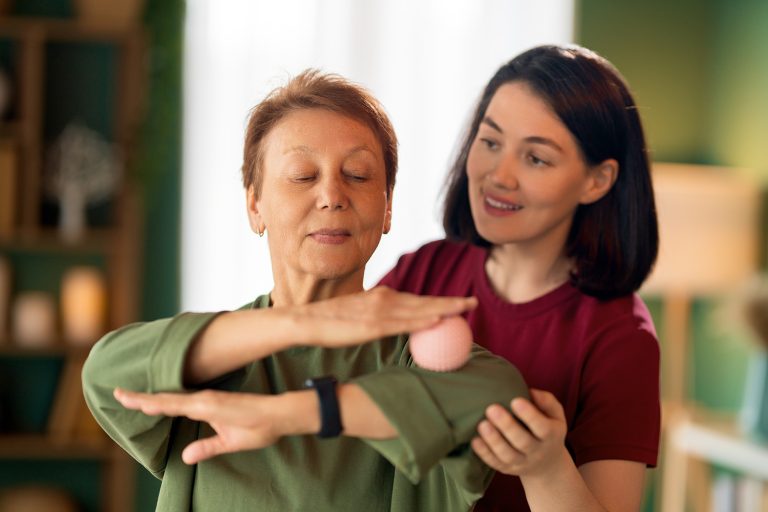

Tennis Elbow Without Playing Tennis?
While tennis elbow and its sister ailment, golfer’s elbow, sound like the unfortunate results of overly active country club memberships, these repetitive use conditions affect more than just those who regularly hit the links or swing a racquet. In fact, tennis plays a factor in fewer than 5 percent of all tennis elbow diagnoses.
But despite the causes of these common soft-tissue injuries to the forearm and elbow, both conditions and the debilitating pain that come with them can be effectively treated and prevented.
The name ‘tennis elbow’ can definitely be a misleading one as it can affect anyone who frequently grips and twists their arms while swinging, carrying, or using a tool. This includes carpenters swinging hammers and turning screwdrivers, and landscapers or gardeners picking up rock, brick or pavers. It can even affect people who spend their days using a computer.
Tennis elbow, or lateral epicondylitis, is an overuse condition in the forearm muscles that leads to pain in the outside of the elbow. A condition that affects 1 to 3 percent of the population, tennis elbow is similar to golfer’s elbow (called medial epicondylitis by clinicians), which in contrast results in pain on the inside of the elbow.
The pain can happen at once or develop over time, and it can get worse when you grip, turn or twist things with your hand – say turning a door knob or opening a jar. While they’re not considered serious conditions, both tennis and golfer’s elbow can lead to long-term pain and possible tissue degeneration without proper rest and treatment.
The first key in treating the pain and inflammation that comes with tennis and golfer’s elbow starts with rest, ice and compression. Once the inflammation begins to subside, treatments can include exercises designed to restore flexibility and mobility while strengthening areas around the joint – all with an eye toward future injury prevention.
Such exercises – all performed in a seated position with the forearm parallel to the floor – may include:
Supination with a Dumbbell: Keeping your forearm steady and your palm up, grip the end of a light dumbbell (or heavy tool, like a hammer). Using only your wrist, steadily turn the dumbbell downward toward the floor, then rotate it to point back up toward the ceiling. Repeat, holding your elbow steadily in place. This strengthens the supinator muscle, the large muscle in your forearm which attaches to your elbow.
Wrist Extension: Using the same dumbbell, grab its center with your palm pointed down. Keeping your elbow steady, bend your wrist toward the floor, then lift back up so the back of your hand is even with your forearm. Repeat. This works the wrist extensors, the small muscles connected to the elbow that allow you to bend your wrist.
Write Flexion: Following your wrist extensions – again, holding the same light dumbbell – turn your forearm so it’s pointed up. Holding your elbow and forearm steady, curl your wrist upward, then slowly drop back to your starting position. Repeat. This exercise works your wrist flexors, the muscles opposite of your wrist extensors.
Such exercises and others can help you prevent elbow pain common with tennis elbow. However, if you experience any pain in or around your elbow that may limit your ability to work, play or perform common daily functions, contact your physical therapist first for a thorough evaluation and to discuss treatment options.
Please Share
categories
Recent Posts
categories

Tennis Elbow Without Playing Tennis?
While tennis elbow and its sister ailment, golfer’s elbow, sound like the unfortunate results of overly active country club memberships, these repetitive use conditions affect more than just those who regularly hit the links or swing a racquet. In fact, tennis plays a factor in fewer than 5 percent of all tennis elbow diagnoses.
But despite the causes of these common soft-tissue injuries to the forearm and elbow, both conditions and the debilitating pain that come with them can be effectively treated and prevented.
The name ‘tennis elbow’ can definitely be a misleading one as it can affect anyone who frequently grips and twists their arms while swinging, carrying, or using a tool. This includes carpenters swinging hammers and turning screwdrivers, and landscapers or gardeners picking up rock, brick or pavers. It can even affect people who spend their days using a computer.
Tennis elbow, or lateral epicondylitis, is an overuse condition in the forearm muscles that leads to pain in the outside of the elbow. A condition that affects 1 to 3 percent of the population, tennis elbow is similar to golfer’s elbow (called medial epicondylitis by clinicians), which in contrast results in pain on the inside of the elbow.
The pain can happen at once or develop over time, and it can get worse when you grip, turn or twist things with your hand – say turning a door knob or opening a jar. While they’re not considered serious conditions, both tennis and golfer’s elbow can lead to long-term pain and possible tissue degeneration without proper rest and treatment.
The first key in treating the pain and inflammation that comes with tennis and golfer’s elbow starts with rest, ice and compression. Once the inflammation begins to subside, treatments can include exercises designed to restore flexibility and mobility while strengthening areas around the joint – all with an eye toward future injury prevention.
Such exercises – all performed in a seated position with the forearm parallel to the floor – may include:
Supination with a Dumbbell: Keeping your forearm steady and your palm up, grip the end of a light dumbbell (or heavy tool, like a hammer). Using only your wrist, steadily turn the dumbbell downward toward the floor, then rotate it to point back up toward the ceiling. Repeat, holding your elbow steadily in place. This strengthens the supinator muscle, the large muscle in your forearm which attaches to your elbow.
Wrist Extension: Using the same dumbbell, grab its center with your palm pointed down. Keeping your elbow steady, bend your wrist toward the floor, then lift back up so the back of your hand is even with your forearm. Repeat. This works the wrist extensors, the small muscles connected to the elbow that allow you to bend your wrist.
Write Flexion: Following your wrist extensions – again, holding the same light dumbbell – turn your forearm so it’s pointed up. Holding your elbow and forearm steady, curl your wrist upward, then slowly drop back to your starting position. Repeat. This exercise works your wrist flexors, the muscles opposite of your wrist extensors.
Such exercises and others can help you prevent elbow pain common with tennis elbow. However, if you experience any pain in or around your elbow that may limit your ability to work, play or perform common daily functions, contact your physical therapist first for a thorough evaluation and to discuss treatment options.
Please Share







